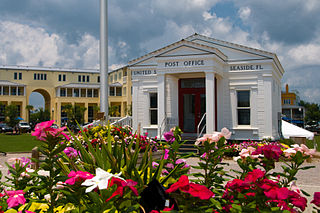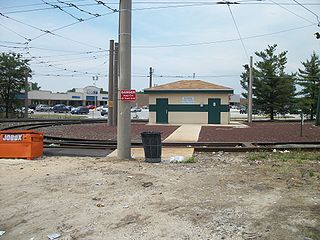Related Research Articles

In urban planning, the grid plan, grid street plan, or gridiron plan is a type of city plan in which streets run at right angles to each other, forming a grid.

New Urbanism is an urban design movement that promotes environmentally friendly habits by creating walkable neighbourhoods containing a wide range of housing and job types. It arose in the United States in the early 1980s, and has gradually influenced many aspects of real estate development, urban planning, and municipal land-use strategies. New Urbanism attempts to address the ills associated with urban sprawl and post-Second World War suburban development.

Poundbury is an experimental urban extension on the western outskirts of Dorchester in the county of Dorset, England. The development is led by the Duchy of Cornwall, and had the keen endorsement of King Charles III when he was Prince of Wales and Duke of Cornwall. Under the direction of its lead architect and planner Léon Krier, its design is based on traditional architecture and New Urbanist philosophy. The 2021 census showed a population of 4,100.

A dead end, also known as a cul-de-sac, or a no-through road or no-exit road, is a street with only one combined inlet and outlet.
A Los Angeles Police Department C.R.A.S.H. initiative that began in April 1987, Operation Hammer was a large scale attempt to crack down on gang violence in Los Angeles, California. A year later, the LA Times reported a double-digit drop in gang violence in parts of the city. After a group of people at a birthday party were shot down on their front lawn in a drive-by shooting, Chief of Police Daryl F. Gates responded with a roundup of gang members. At the height of this operation in April 1988, 1,453 people were arrested by one thousand police officers in South Central Los Angeles in a single weekend.

A fashion week is a week-long fashion industry event where fashion designers, brands, or "houses" display their latest collections in runway fashion shows to buyers and the media which influences upcoming fashion trends for the current and approaching seasons.

James Arthur David Hope, Baron Hope of Craighead, is a retired Scottish judge who served as the Lord President of the Court of Session and Lord Justice General, Scotland's most senior judge, and later as first Deputy President of the Supreme Court of the United Kingdom from 2009 until his retirement in 2013. He had previously been the Second Senior Lord of Appeal in Ordinary. He is the Chief Justice of Abu Dhabi Global Market Courts.
The National Extremism Tactical Co-ordination Unit (NETCU) was a British police organisation funded by, and reporting to, the Association of Chief Police Officers (ACPO) that coordinated police action against groups in the United Kingdom it described as extremist.

The street hierarchy is an urban planning technique for laying out road networks that exclude automobile through-traffic from developed areas. It is conceived as a hierarchy of roads that embeds the link importance of each road type in the network topology. Street hierarchy restricts or eliminates direct connections between certain types of links, for example residential streets and arterial roads, and allows connections between similar order streets or between street types that are separated by one level in the hierarchy. By contrast, in many regular, traditional grid plans, as laid out, higher order roads are connected by through streets of both lower order levels. An ordering of roads and their classification can include several levels and finer distinctions as, for example, major and minor arterials or collectors.
Neighbourhood Watch in the United Kingdom is the largest voluntary crime prevention movement covering England and Wales with upwards of 2.3 million household members. The charity brings neighbours together to create strong, friendly and active communities in which crime can be tackled. Neighbourhood Watch Network is the umbrella organisation supported by the Home Office to support Neighbourhood Watch groups and individuals across England and Wales.

Eastwick is a neighborhood in the Southwest section of Philadelphia, Pennsylvania, United States. It is the southwesternmost neighborhood in the city, bordering Philadelphia International Airport and the city line with Delaware County at Cobbs Creek and Darby Creek. The Elmwood Park neighborhood borders it to the northeast.

Radburn design housing is a concept for planned housing estates, based upon a design that was originally used in the community of Radburn within Fair Lawn, New Jersey, United States.

Honeycomb housing is an urban planning model pertaining to residential subdivision design.

The Conservative Campaign Headquarters (CCHQ), formerly known as Conservative Central Office (CCO), is the headquarters of the British Conservative Party, housing its central staff and committee members, including campaign coordinators and managers.

SelectaDNA is a forensic property marking system used as part of crime prevention strategies for businesses and residential properties.

C3 policing, also known as the Avghani model, is a crime prevention strategy for civilian law enforcement, loosely developed from military counterinsurgency strategies and currently used in the cities of Springfield and Chicopee in Hampden County, Massachusetts, United States.
TheWriters' Prize, previously known as the Rathbones Folio Prize, the Folio Prize and The Literature Prize, is a literary award that was sponsored by the London-based publisher The Folio Society for its first two years, 2014–2015. Starting in 2017, the sponsor was Rathbone Investment Management. At the 2023 award ceremony, it was announced that the prize was looking for new sponsorship as Rathbones would be ending their support. In November 2023, having failed to secure a replacement sponsor, the award's governing body announced its rebrand as The Writers' Prize.
The UK Home Office hostile environment policy is a set of administrative and legislative measures designed to make staying in the United Kingdom as difficult as possible for people without leave to remain, in the hope that they may "voluntarily leave". The Home Office policy was first announced in 2012 under the Conservative-Liberal Democrat coalition. The policy was widely seen as being part of a strategy of reducing UK immigration figures to the levels promised in the 2010 Conservative Party Election Manifesto.

Extinction Rebellion is a UK-founded global environmental movement, with the stated aim of using nonviolent civil disobedience to compel government action to avoid tipping points in the climate system, biodiversity loss, and the risk of social and ecological collapse. Extinction Rebellion was established in Stroud in May 2018 by Gail Bradbrook, Simon Bramwell, Roger Hallam, Stuart Basden, along with six other co-founders from the campaign group Rising Up!
References
- 1 2 Burke, Jon (2022-06-09). "Greening the city needs to happen – why are the police standing in the way?". The Architects’ Journal. Retrieved 2024-08-02.
- ↑ "Secured by Design - About SBD". www.securedbydesign.com. Retrieved 2024-03-15.
- ↑ "Secured by Design - About SBD". www.securedbydesign.com. Retrieved 2024-03-15.
- ↑ https://www.securedbydesign.com/images/HOMES_GUIDE_2023_web.pdf Secured by Design: Homes 2023 (PDF), 2023
- ↑ ""More than 30 years after she left office Margaret Thatcher's stamp on the city remains"". Dezeen. 2023-02-20. Retrieved 2024-08-02.
- 1 2 3 "Can we design away crime?". ww3.rics.org. Retrieved 2024-03-15.
- ↑ Bacon, Gareth (25 May 2016). "London Assembly".
- ↑ McInnes, Alan (2012-11-06). "Don't call our homes oppressive. They are well secured, and people like them". The Guardian. ISSN 0261-3077 . Retrieved 2024-08-02.
- ↑ Harper, Phineas (2024-03-13). "Comment: 'the Metropolitan Police shouldn't get a say in designing London's streets'". Evening Standard. Retrieved 2024-03-15.
- ↑ Hart, Kim (March 2020). "Why city planners are killing the cul-de-sac". Axios. Retrieved 15 March 2024.
- ↑ Russell, Herbie (22 September 2023). "Southwark Council destroys Walworth flower walkway in ongoing anti-social behaviour crackdown". Southwark News. Retrieved 15 March 2024.
- ↑ "Controversy after police remove benches and bushes". Kent Online. 2022-04-22. Retrieved 2024-03-15.
- ↑ Harper, Phineas (2022-05-02). "Removing benches, blocking cycle paths: why are police interfering in the UK's public spaces?". The Guardian. ISSN 0261-3077 . Retrieved 2024-03-15.
- ↑ Letters (2022-05-05). "Backing for police in the battle over park benches". The Guardian. ISSN 0261-3077 . Retrieved 2024-08-02.